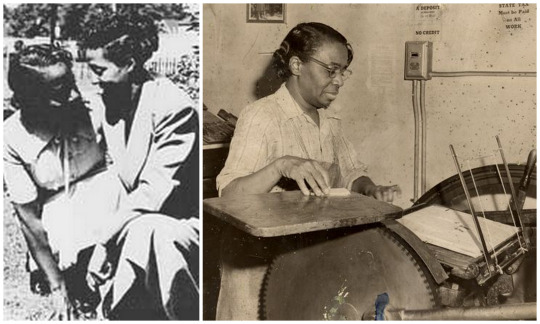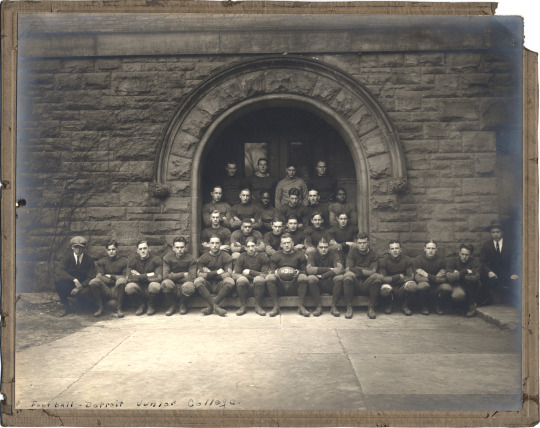#detroit history
Text

Humorous postcard depicting a man pushing a woman in a wheelbarrow. "Seeing Detroit" is painted on side of wheelbarrow.
Burton Historical Collection, Detroit Public Library
#humorous#postcards#detroit#detroit history#seeing detroit#wheelbarrow#vintage#vintage postcards#detroit public library
25 notes
·
View notes
Text

Cadillac Square,
Detroit, Michigan - United States
(1917)
8 notes
·
View notes
Text

J Dilla’s childhood home in Detroit where Slum Village was born.
21 notes
·
View notes
Text



"The only way we can get any place is by being together."
Ruth Ellis is an icon, particularly in the city she and her partner called home for most of their lives: Detroit. Born to former slaves, Ruth came into this world in 1899, and in the 101 years she was on this earth, she lived her life fully and openly, often touted as the oldest "out" lesbian when she passed in 2000. She became open about her identity at the age of 16 in 1915, but claims never to have "come out" to her family, as they always knew and accepted her. She spent her days working at a printing press in Illinois, where she met her partner, "Babe" Franklin. The pair moved to Detroit in search of a better life, and after several years, the pair opened their own printing shop on the first floor of their home.
In a time when homosexuality was illegal, Ruth and Babe opened the doors of their home to the LGBTQ community, who were denied access to both white gay clubs and black straight clubs. It was colloquially known as "the gay spot," a place where folks could congregate and enjoy a welcoming atmosphere decades before the Black Civil Rights Movement and the Stonewall Riot would begin to alter their outlook and options. She also opened up the extra rooms in her home to help house LGBTQ community members and helped find resources for those in need, even putting a few through college.
Prior to her passing, the Ruth Ellis Center opened in her adopted city, Detroit, where it continues to honor her legacy by providing shelter and aid to the LGBTQ community and youth.
#lgbt history#lgbtq history#pride month#lgbtq pride#ruth ellis#black history#detroit history#the gay spot#vintage lesbians#sapphics#wlw#gay history#lesbian history#queer history
9 notes
·
View notes
Text

Faygo was founded in Detroit, Michigan, in November 1907, as Feigenson Brothers Bottle Works by Russian baker immigrants Ben and Perry Feigenson. The original flavors of Faygo (fruit punch, strawberry, and grape) were based on cake frosting recipes used by the Feigensons in Russia. Initially, the brothers used a horse drawn wagon for deliveries and lived above the bottling plant.
The business grew over the next 10 years. The Feigensons were able to purchase houses, hire their first employee and a second wagon and horse for deliveries. More flavors were added including Sassafras Soda and Lithiated Lemon. They built a new plant due to their success on Beaubien Street in Detroit.

In 1921 as the company expanded, they decided the brand name "Feigenson Brothers" was too long and changed it to Faygo. The brothers bought their first delivery truck in 1922, and started home deliveries the following year. New flavors in the 1920s were a vanilla flavored soft drink, a seltzer water, "Ace Hi" (similar in flavor to Nehi), and Rock and Rye (named after a Prohibition Era drink). The company opened its currently operating bottling plant in 1935 on Gratiot Avenue in Detroit.
Jim Henson's Muppets, Inc. produced a small series of ads for Faygo strawberry soda starring the Muppet characters Wilkins and Wontkins

The brothers ran the company until the mid-1940s, when they turned it over to their sons. In 1956, the company created a series of radio and television advertisements featuring a fictional cowboy called the Faygo Kid, who was portrayed in animation for television commercials for Faygo Old-Fashioned Root Beer.






With 50 flavors to choose from your bound to find a favorite.
Red Pop
Diet Redpop
Rock N' Rye
Diet Rock N' Rye
Root Beer
Diet Root Beer
Cotton Candy
Orange
Diet Orange
Grape
Diet Grape
Moon Mist
Diet Moon Mist
Moon Mist Blue
Candy Apple
Cola
Diet Cola
Creme Soda
Diet Creme Soda
60/40
Diet 60/40
Black Cherry
Peach
Diet Peach
Dr. Faygo
Gold
Diet Gold
Ginger Ale
Diet Ginger Ale
Twist
Diet Twist
Cherry Cola
Pineapple
Pineapple Watermelon
Pineapple Orange
Jazzin' Blues Berry
Raspberry Blueberry
Fruit Punch
Ohana Punch
Ohana Lemonade & Iced Tea
Ohana Lemon Iced Tea
Ohana Lemonade
Ohana Strawberry Banana
Ohana Raspberry Lemonade
Ohana Kiwi Strawberry
Sparkling Water
Sparkling Cherry
Sparkling Grapefruit
Sprakling Orange
Sparkling Lemon Lime
Tonic Water
Diet Tonic Water
Club Soda
10 notes
·
View notes
Link
Double podcast episode about the League of Revolutionary Black Workers in Detroit in the late 60s/early 70s. We hear from former members of the group including Herb Boyd, General Baker, Darryl “Waistline” Mitchell, as well as Dan Georgakas, co-author of Detroit I Do Mind Dying.
Content note: these episodes contains two brief mentions of sexual violence
Our podcast is brought to you by our patreon supporters. Our supporters fund our work, and in return get exclusive early access to podcast episodes, bonus episodes, free and discounted merchandise and other content. Join us or find out more at patreon.com/workingclasshistory
You can listen to our podcast on the below links, or on any major podcast app. Links to a few below.
This is an improved, extended and partially re-recorded version of our podcast episode 12. We have added more audio clips from other members of the League and added narrative for additional detail, context and to tell the story in a more cohesive manner. Whether you listened to the original episode or not, we hope you enjoy it!
#podcast#podcasts#detroit#history#league of revolutionary black workers#union workers#workers rights#workers vs capital#workers#labor vs capital#labor rights#capital vs labor#skilled labor#labor#labor movements#labor movement#collective action#working class history#detroit history
1 note
·
View note
Text



Reading and cleaning. This book is quite old and brittle and valuable. The Tonnancour books are fascinating.
0 notes
Text

"Degenerate Confesses To Atrocious Crime," Windsor Record. October 3, 1912. Page 1.
---
Admits Deeds of Same Nature - He Leads Detectives to Scene of Outrage and Describes Horrible Act.
---
Was Trusted Friend of Girl.
----
Officers' Blood Runs Cold as Half-Witted Character Describes How he Murdered Little Tildie Reis.
----
A full confession of the killing of Tillie Reis, the 12-year-old girl whose mutilated body was found near her home in Detroit Tuesday evening, was made Wednesday night by her cousin, George Spengler. In spite of the fact that his relatives declare his crime impossible his confession was so correct in every detail that the police express not the slightest doubt that he is the criminal.
Hardly a detail was lacking that could make the crime more horrible. Spengler knew the girl well, was trusted by her, and had long been a welcome visitor at the home of her father, his uncle. He waited for her by the alley, with every detail of the crime he committed formed in his mind. After washing away the the evidences of guilt, he borrowed a quarter from a friend and spent part of the evening at a moving picture show in the neighborhood. Then he went quietly to bed, and was sound asleep when detectives arrived to arrest him.
With hanging head and crimsoned cheeks, the man told his every movement from the time be quit work at 5 o'clock until he was aroused by the detectives at 2 a.m. Wednesday and taken to Central station.
Beside confessing to attacks on other girls, he talked of killing ani- mals for the pleasure of seeing them die. He spoke of debaucheries freely.
But through all his talk, when certain subjects were mentioned, he hung his head and his cheeks burned red. Of the killing he spoke without emotion, but of the motives that lead up to it he would not talk without the severest cross-examination.
He cried continually as he made his first confession to Bert Erke, doorman of the cell block at Central station.
"I loved that girl. I love her now. But I had to kill her." he sobbed. "She would have screamed."
To George Kelly, assistant prosecutor, he coolly announced that he "waited for her to kill her."
"Tillie was such a nice girl. Yes, I knew her. I knew her father. I knew her mother and brothers. Tillie was my little friend," he said.
Spengler lives with his father and mother at 537 Elmwood avenue, Detroit. He is said to be half-witted by those who have known him long. He has a trick of passing his hand over his forehead, and taking some time to collect his thoughts. His eyes are unsteady. He is thin, andersized and appears poorly nourished. He spoke in a low volce throughout. Picture shows and solitary debauches are his only form of recreation. He is a steady worker and has been working 16 straight weeks in a mill at the foot of Dubois street, he says.
After the killing Spengler stopped Thomas Copeland, employed by a local motor company, and asked him to brush from his clothes mud that bad stuck there in the alley in the rear of the Reis home, where the crime was committed. He then begged 25 cents from Mr. Copeland and spent part of it in a visit to a picture show near the scene of the killing.
The degenerate sobbingly told of how he had gone from his home to the mouth of the alley and waited for "Tillie" with the set purpose of doing as he did. He told of her fearlessness, suspecting nothing and having known him long, she allowed him to walk a short distance with her. He told how she broke from him and ran when she took offense at his words, of how he chased her, his hand feeling in his pocket for his knife as he did so, how he caught her and she screamed for help, and how be stopped that scream. He told how her body fell against his arm, and of how he sobbed as he knew she was dying, but was not deterred from his purpose.
He denied being frightened away by the approach of the two boys who found the the body, although they told the detectives they saw him running across a vacant lot.
"I never did such a thing before. I never killed a girl in all my life before," he pleaded in closing his confession.
Tells of Previous Crime.
On the subject of previous attempts on young girls, it took the hardest kind of questioning to draw him out. At first he denied he had ever before made such attacks, but later he admitted in a confused way having attacked girls on the street and having climbed through bedroom windows.
He finally described in detail an outrage on a giri near Holcomb and Mack avenues, supposedly Gladys Luke, 10 years old, who lives with her parents at 723 Holcomb avenue and was attacked Feb. 14.
THE PERVERT'S LIST OF CRIMES
HELEN BROWN - Thirteen, years old, murdered December 10, 1900: lived at 100 Jones street, Detroit.
MATILDA REIS - Aged twelve years, 950 Beaufait street, murdered October 1. 1912.
GLADYS LUKE - Ten years old, assaulted February 14, 1912: lived at 722 Holcomb street.
ELIZABETH KRELL- Eleven years old, assaulted November 29, 1911: lived at 142 Hancock street.
Picture:
GEORGE SPENGLER
Half-witted creature who confesses to shocking crimes across the river
#detroit#murder#serial killer#criminal psychopath#murder investigation#child murder#history of crime and punishment#detroit history
0 notes
Text

Football team and staff in arched doorway of stone building. Central player holds ball labeled "D - 1922." Handwritten on photograph front: "Football - Detroit Junior College."
Burton Historical Collection, Detroit Public Library
#football#detroit junior college#detroit#1922#detroit history#vintage#1920s#junior college#football team#sports#sports history#detroit public library
24 notes
·
View notes
Text
Memories of Boblo Island
Hello Friends, Come over to my blog to read a story about my memories of a place called Boblo Island, aka Bois Blanc Island.
lynnlawlerbooks.com/news/2023/7/22/memories–of-boblo-island
Until Next Time,
Lynn
www.lynnlawlerbooks.com
Click here to sign up for my newsletter
Photos are subject to copyright.
Copyright 2023

View On WordPress
0 notes
Text


Heritage, Vol 2 No 5. "Last of the Land Barrons" (1985)
0 notes
Text
Drag and The White Stripes






In the Cass Corridor of Detroit from 1956 to the late 80s, The Gold Dollar opened its doors for drag performers in the area.
Performers like Gorgeous Gussy, who entertained people from the 50s to the 70s in bars such as Golden Slipper, The Diplomat, and the Gold Dollar. Fat Jack was another pillar of the community from the 60s and 70s that was best known for her performances of “Itsy Bitsy Teenie Weenie Yellow Polka Dot Bikini.” Fat Jack passed away in 1995 and Gorgeous Gussy in 1997. Both pictured above.
In 1996 the venue began booking live bands and it quickly became a right of passage for young musicians of the garage band scene of Detroit. In August of 1997, The White Stripes played their first show in the club and became regulars, adding more the the already rich history of The Gold Dollar.
In 2001 the venue closed for good and was left open for trespassers until a mysterious fire broke out in 2019, ultimately causing it to be demolished.
#Detroit#the white stripes#Jack white#Meg white#Detroit history#lgbtqiia+#lgbtq+ history#the gold dollar#lgbtqia+ history
1 note
·
View note
Text
1 note
·
View note
Text


Pedestrian Underpass from the 1930’s. Highland Park, MI (Detroit)
0 notes
Text
My Original Work: "War Against the High Cost of Living", A Local History, Now Published On My Blog
I wanted my original work about Polish-American women labor strikes in Hamtramck/Detroit to be accessible to others who were interested in learning. I have published the entire file on my blog! #history #women #detroit #greatdepression #hamtramck
I cannot believe it has already been six years since I wrote my capstone project at university. I still remember all the work that went into it. I traveled back and forth from my university and Detroit. I spent hours in the Detroit Public Library archives combing over newspaper articles from the 1930s. I visited museums in Hamtramck and found the inspiration for my story. I was reading over it…

View On WordPress
#1930s#20th century#American History#depression era#detroit history#ethnic groups#great depression#hamtramck#history#history blog#housewife#labor history#local history#mary zuk#polish-american history#strikes#thesis#womens history
0 notes
Text
youtube
Greetings from Detroit
0 notes